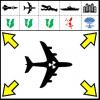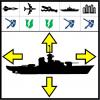So I've been working on my submission from the December GDS, and I've run into complaints from playtesters. My submission, TRIAD, is intended to be a light, 2-player, 10-minute game that only uses 14 pieces and a 5x5 grid gamemat (in keeping with the design parameters).
I've ended up with a system of 4 unique units, each of which beats and is beaten by a unique set of those units. After around 30 solo playtests with the same ruleset, I've obviously got that system memorized. Unfortunately, I've had a hard time communicating the rules with playtesters. I've used a player's aid, but that won't work for the finished product; the units themselves (1.75" squares) need to adequately communicate what they can beat and what they lose to.
Attached are 3 sample units. At the top, you see the 4 units (ignore the city icon); beneath each one is a broken sword (attacker dies), a broken shield (defender dies), a "bounced" shield (nobody dies), or a mushroom cloud (city is nuked). I feel like the graphics work fine to communicate the results of an attack, but if it doesn't work for players, then it is no good.
Also attached is the table that I need to encode within the units. This is essentially the player's aid that I'd like to have but can't.
There are only possible 4 results when one unit attacks another:
-Attacker dies
-Defender dies
-Both unit die (usually in the case of ICBMs detonating...)
-Nothing happens and both units remain exactly as they were before the attack
So, any better ideas on how to communicate the relationships? Is it hopeless trying to encode complex relationships between 4 different units with a method that fits inside a 1.75" square in an 10-minute game? Or do I just try to find better playtesters...?
Thanks,
Werhner







